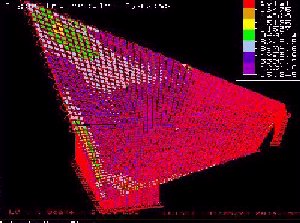READERS COMMENTS
COMMENT NUMBER 1
Dear Mr. Milo Ketchum,
We are two Italian Civil Engineering students; we were searching on
the web for information about concrete shells, when we found your web
site. Alas! We couldn't find any other site as interesting, detailed and
exhaustive as yours.
We are designing a concrete shell (an hyperbolic paraboloid), inspired
on Candela's "La Capilla de Nuestra Senora de la Soledad" known as "El
Altillo Chapel", so we were very pleased to see that your site is full
of Candela's works.
We attach to our message a picture of the model we used to analize our
shell with a FEA program, SuperSAP. It is a self-extractor file.
The shell is supported by concrete walls and metal pillars (represented
by circles on the edge of the shell). There is a beam running along the
edges of the shell: it is 10 inch wide and its height changes from 32 to
7 inch. The window top-right gives the stresses in KN/m^2 (Von Mises
criterion).
The stress pattern is not simmetric because of the wind blowing from one
side.
The shell is 112 feet long and 89 feet wide. It is 4 inch thick.
We had some problem while calculating the steel reinforcement. The main
problems were on the edges of the shell and next to the concrete walls.
Unfortunately in Italy there are no specific regulations (or books) on
the matter. We wonder if you could suggest us where to find information
(in your site you talk about American Concrete Association regulations:
do they have a web site with these rules?) or if you may personally help
us.
Thank you very much for your time.
We hope to hear from you soon.
Alessandra Pasqua, Guido Maccone
Dear A and G
A characteristic of Candela's shells is that they are pecularily fitted
to be built in snow less climates. The edge members in these climates
take less thrust and therefore may be made smaller, so that the
torsinal stresses are less. I know. The only failure I had was in a a
"saddle hypar" in an edge member due to torsion. The next hypar we
prestressed all the members, and it has been completely sucessful. Look
at the "Broadmoor Shell" in "A Short Tutorial".
This is your chance to solve that problem. One answer is to make the
shell thicker at the supports, thus reducing the torsion. I have always
wanted to analyse Candela's shell by FEM. The only problem he ever
mentioned to me was a torsional failure at supports of the shell for the
Bourse (stock exchange).

REPLY